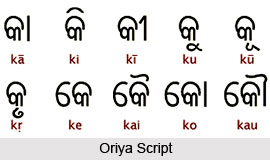 The Oriya script, also known as Utkalakshara or Utkala Lipi, is usually utilised to write down the Oriya language, which is the dialect of the state of Oriya, situated on the east coast of India. But, it is also used for inscribing various other languages of India like Sanskrit. Oriya script has originated from the Kalinga script. While according to other experts, the Oriya script has evolved from an early structure of Bengali script. Although the cursive shape of the Oriya alphabets seems to be influenced by Southern lettering, but it is widely believed that such shape has evolved with the need for writing on palm leaves with a pointed stylus. As the use of many straight lines have a tendency to rip and slit the palm leaf, the curved appearance had to be developed.
The Oriya script, also known as Utkalakshara or Utkala Lipi, is usually utilised to write down the Oriya language, which is the dialect of the state of Oriya, situated on the east coast of India. But, it is also used for inscribing various other languages of India like Sanskrit. Oriya script has originated from the Kalinga script. While according to other experts, the Oriya script has evolved from an early structure of Bengali script. Although the cursive shape of the Oriya alphabets seems to be influenced by Southern lettering, but it is widely believed that such shape has evolved with the need for writing on palm leaves with a pointed stylus. As the use of many straight lines have a tendency to rip and slit the palm leaf, the curved appearance had to be developed.
Origin of Oriya script
Oriya script has been developed from Kalinga script that was used to write ancient Dravidian language. The Kalinga script is a form of the ancient Brahmi script that was used in India. The oldest Oriya script influenced by the Kalinga script can be traced back to 1051. The origin of Oriya language can be glimpsed from the inscriptions of Kharavela at Hati Gumpha of Khandagiri and the script in the Ashokan decrees at Jaugada and Dhauli. The writings of Hati Gumpha closely resemble the modern Oriyan language, rather than the language in the Ashokan edicts. It is also believed that Pali was the original language of Orissa as the inscriptions of Hati Gumpha are in Pali language. Moreover, there are also similarities in oriya scripts and Thai scripts.
Structure of Oriya script
Oriya is an abugida or a syllabic alphabet where all consonants contain an inherent vowel entrenched within. Diacritics, which can emerge before, after, above or below the consonant they belong to, are utilised to modify the form of the intrinsic vowel. Vowels are written as independent letters, when the diacritics emerge at the beginning of a syllable. Furthermore, when specific consonants appear together, particular conjunct symbols are used which merge the vital parts of each consonant symbol. Vowel diacritics can be combined with the consonants, though such ligatures are not much practiced in modern printing.
The Oriya script consists of few ambiguities which increases the difficulties for the beginners. Some of the basic characters of the alphabet may be confused. In order to reduce the vagueness, a small oblique stroke is used at the lower right end as a diacritic.
Oriya script was included in the Unicode Standard in October of 1991 with the release of version 1.0. The Unicode block for Oriya Script is U+0B00-U+0B7F.



















